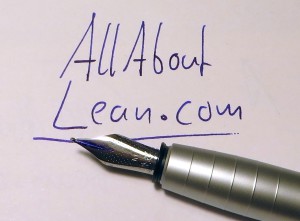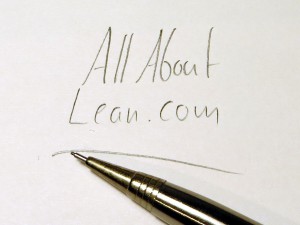
In many lean books and other writing, it is often recommended to use a pencil for certain tasks as, for example, the A3 report. Yet, I have seen very few uses of pencil in lean manufacturing in the Western world. Most of the documents are computer printouts based on Excel, PowerPoint, or Word. The few handwritten documents are usually done in pen (see also my post on The Advantage of Handwritten Data on the Shop Floor).
In this post I will look into why almost nobody uses pencils and why it would be good to use more pencils. I myself am also guilty of that, but I plan indeed to use more pencil in the future.
The Mighty Fountain Pen

In public perception, the ultimate writing instrument is the fountain pen. It is the weapon wielded by the mighty. It is designed to leave a mark for eternity. Many people prize their high-quality fountain pen. There is even a Fountain Pen Day on the first Friday of November.
The most expensive pen on Amazon.com at the time of writing was a (in my view, rather ugly) Montegrappa Chaos Limited Edition 18K Gold Fountain Pen Fine Point for an eye-popping $65,700.00 – but it comes with free shipping 🙂 . As usual with such high-priced products, the reviews are quite entertaining. Still, not a pen for me. With that money, I’d rather buy a car.

Even I use a (red) fountain pen for grading exams, to show respect for the significance of the document I am checking. My blue fountain pen, however, I use very rarely, simply because I usually have a normal pen closer nearby. Last time I used it was for an image for this blog post. Before that I used it to sign my real estate purchase contract.
Most of you are probably writing with less fancy pens. Most common are ballpoint pens, felt tip pens, or rollerball pens. Quick and easy. In any case, all of them are permanent!
Why a Pencil is Better in Lean

While it is often useful to write with a permanent pen (e.g., in many exams it is even a requirement), it is difficult to change afterward.
Yet, lean is all about change! Continuous improvement means continuous change. Very little is permanent. What may be a good way today may be old hat tomorrow. This applies to both improvements and setbacks.
For example, I recently did three days’ worth of workshops (plus preparation and wrap-ups). When it came to the implementation, we received news that upper management decided to do a fundamental change in the organization. As a result, the entire project was no longer needed 😕 . What a bummer … but that’s life.

Also, as per my previous post The Advantage of Handwritten Data on the Shop Floor, you could do this on a computer. However, it goes much faster and easier with pen(cil) and paper. It sounds cliche, but using a computer requires a lot of your brain power, leaving less for your creativity. For example, a processor gave students the task of designing a barbecue grill. Some teams had to do it on computer, some in pencil. Overall, the pencil designs were much better and more creative than the computer ones.
Where to Use a Pencil
In lean, many documents are continuously updated. A prime candidate is the A3 report for problem solving. It is highly recommended to do this in pencil. It is highly unlikely that someone can do an A3 correctly from scratch, as it usually goes through multiple rounds of revisions. Therefore, data is continuously added and erased.
Another good candidate is a value stream map. Every time you walk through the shop floor, you will find additional data that goes in and other data that has to be erased. If you want to use a value stream map for improvement, use pencil – although most value stream maps I have seen in the West were unfortunately done only to impress management, in which case you should just make it shiny.
Yet another candidate is work standards. This may be surprising. In the West, a standard is given from above and then rarely changed. In Japan, however, workers have much more freedom to influence, and especially improve, the standard. This is often done by adding additional points by pencil until the standard can be updated. Of course, you still have to make sure that the workers follow the new standard (which is often the part skipped in the Western world).
Finally, reports and documentation on the shop floor can also be done in pencil. This writing and erasing can be very useful for the regular status updates in the team corner, for problem solving, and for many other frequently changing documents.
Why Westerners Use Pens and Japanese use Pencil

In the Western world, I have the feeling that a pencil is often looked down upon. However, in Japan, people write quite frequently with a (mechanical) pencil. I think this is due to the difference in school education.
In Germany, where I received my education, we started writing with a fountain pen. In the United States some schools also require a fountain pen, although others also use pencil. Some schools even have a pen license where children with proper pencil handwriting are allowed to graduate to a fountain pen. Other schools simply forbid ballpoint pens and other pens. With these rules, you grow from being a kid with crayons to being an adult with a fountain pen. Overall, much of the writing in Western schools emphasizes fountain pens.

In Japan, however, much of the writing in school is done with a pencil. A saying in Japan is that your writing reflects what your heart looks like. Using a pencil makes it easier to erase mistakes – and to provide a flawless handwriting, even if it is not on the first try.
As a result, Japanese have much less bias against pencil, and feel much more comfortable using it. Hence, they have no problem with creating documents in pencil. In the Western world, pencil seems to have a dirty and uneducated feel, and people are much more hesitant to use pencil for documents someone else can see.
This can even be extended to a wider view of the difference between lean in Japan and lean in the Western world. In Japan, it is absolutely okay to fix, improve, and change until the result is flawless. In the Western world, the goal has to be achieved on the first try, even if there are a few smudges and spots left at the end.
Amazing! The whole difference between Japanese and Western lean boiled down to what we wrote with at school!
Hence, merely using a pencil will magically transform you into a lean expert … or maybe not. Actually, probably not. At best, it is a tiny nudge in the right direction. In any case, I am just happy that (with the help of my wife) I stumbled on this beautiful nugget of a cultural difference between Japan and the West 🙂 .
My Pencil Resolution!
I have to admit that up to now I have rarely used pencils. Having a proper German education, I was conditioned to fountain pens, which my laziness downgraded to ballpoint pens. But I made myself a resolution: From now on I will write more often in pencil.
After a bit of research, I found out that the best mechanical pencils are (unsurprisingly) from Japan. I liked in particular the Uni-ball KuruToga Mechanical Pencil. This pencil rotates the mine while writing, and hence avoids any loop-sided-ness. I went for the 0.5 mm HB medium hardness. I also went for Japanese Pencil Leads, which supposedly break much less than Western mines. Now I just have to find out how not to make a mess in my shirt pocket …
Of course, you can find even better stuff in Japan, where, for example, mechanical pencils with an extremely thin 0.2 mm lead mine are popular. But these are difficult to find outside of Japan, and I am not going to fly to Japan just for a pencil. But next time I am there …
In any case, I hope the above musings on pens and pencils were interesting to you. Maybe you too can grab a pencil instead of a pen next time, before you go out and organize your industry!

My favorite pencil is the Pentel Sharp P207C Mechanical Pencil. A classic and its been there forever. 0.7 lead so it does not break easily. US$ 4 so its not cheap but not too expensive either. Pentel has a pencil eraser that I use with it (its a separate eraser that looks like a pencil in its own right). Sketching with it and coming up with concepts is one of the best aspects of my working life. I also use sketching paper and not lined paper and one of those wire bound books where the pencil and eraser clip into the wire binding. Pad, pencil, coffee, camaraderie and innovation !. Hard to beat !
Hi Dielsh, indeed a nice looking pencil. I also had problems with broken lead, until i switched to Japanese brands. Since then no breaks.
Glad to see that the use of a pencil is not dead in industry 🙂
We found the difference in the use of pencil vs. fountain pen in a US vs. German high school our daughter went to surprising at first, but made more sense after a while. It just became natural and advantageous. Is the US school system already closer to the Japanese than the German system?
Also, the use of pencil is encouraged in many of the mainstream paper-based time management systems to allow for change and adaptation.
So, as Christoph put it, why not supporting its use from the bottom up?
I did not realize there was such a difference in the strength of the Japanese lead. Will try it out. Having said all of that, I think the debate is never really about pencil versus smartphones versus computers. Its always about the right tool for the person and the job and respect for peoples knowledge and good use of their time.
Pencils have evolved to erasable color pencils also to add an additional visual dimension. Anybody tried these out ?
Bernd, great comment. My wife is Japanese and writes a lot suing pencil, too, although she also likes fountain pens in fancy colors.
Dilesh, when I started using mechanical pencils (again), I had lots of breaks, which was always a mess and smudged the paper/table/floor. After I replaced all leads with Japanese ones I did not have a single break, even though I am using the same pencil. I think Japan with their insane attention to detail and their complicated writing system just makes the best writing instruments in the world.
Hello Christoph, Firstly thanks for your most enlightening blog, greatly appreciated. In 1961, after being taught at school that one should always write using a pen, I served in the South African Navy which at that time inherited it’s traditions from the Royal Navy. Astonishingly we were instructed to only use a pencil when filling in the ships log. When inquiring, “why not in ink?” we were told: “Pencil will not be affected by water should the paper get wet,” a good reason obviously learned by seaman, especially in olden days. Best Regards, Jack.
Hello Jack, Wonderful Story! I did not know that. I always thought the logs had to be “tamper proof” using a permanent pen. But then, “water proof” is probably even more important on a ship. Great Story, thanks for sharing 🙂
When I went to elementary school in France in the early 1960s, we had to use quill pens, and sit at desks with ink wells filled by the teachers before start of class each day. Fountain pens were not allowed, because some families might not be able to afford them, and ballpoint pens, which you could get for almost nothing at the corner store, were banished for failing to promote good penmanship. It sounds quaint, but it really was stupid.
In Middle and High School, on the other hand, fountain pens were mandatory, as you experienced in Germany. When I think of Japanese handwriting education, the image that comes to mind is calligraphy with brushes and ink, a medium that does not allow you to correct mistakes. In American schools, both my kids used pencils.
The medium that makes it easiest to correct mistakes isn’t paper and pencil, but the computer screen. With software you don’t master, the tool is in the way of your imagination but, if you do master it, I don’t see it as restricting your creativity in any way.
I still use a fountain pen to take notes. After trying Parker, Mont-Blanc, and Waterman, I have settled on a Namiki Vanishing Point, the only retractable fountain pen I have ever seen. I also have a Rotring 3-lead mechanical pencil with 0.3mm, 0.5mm and 0.7mm leads that I never use.
Hi Michel, Computers do have their use, but in my view especially for graphical things at the design stage (layout, VSM, A3) they often are in the way. I consider myself very good at PowerPoint and make most of my illustrations with it, but for sketching, designing, and changing VSM or A3 i prefer paper.
In any case, it seems pencil is more common in the US than I thought, so I adjusted my post a little. Thanks for the input!
Great philosophy: Pencil vs Pen via @leanvoodoo
#QI #Qualityimprovement https://t.co/R7zbutXQYk
Hi I also use a pencil. A graphgear 1000 0,5, The only disadvantage I find in using a pencil is that it is not scanned clearly afterwards with the camera. I use Evernote and I scan everything. great article by the way
Spyros Bonatsos
hi
nice post.
My favourite topics: fountain pens and mechanical pencils and pens .
my day to work work combination is:
Pilot Capless Fountain Pen
This is a retractable tip fountain pen.
18K nib, in F point size.
My finish is Matte Black.
This pen uses refillable cartridges.
Choice of daily use ink color is Pilot’s Blue-Black.
I use it for meeting notes.
It glides and is expressive.
Staedler F945
This mechanical pencil is aluminium body.
My point size is 0.9 mm.
Lead darkness is 2B.
This is what I use to express my points in a small conference room table setting.
Dark leads are easily readable across the table.
Gemba use, in taxi use, restaurant use always have in my pocket pen: Cross Ion.
Small. About the size of a small sized thumb.
Ink: gel ink cartridges.
Ink color choice: Blue-Black.
Pls note: although discontinued by Cross, you can still easily buy it and the cartridges on amazon or specialty pen shops.
It was launched maybe around 15 years ago or so, but is still (by far) the smallest, extendable, gel ink, pocketable pen.
With rubberized grip and beautiful chrome accents on the Neptune Blue body.
We use pencil inorder for us to to easily erased any mistake we might make.
Great article as ever Jack. I remember fondly receiving letters and postcards from my father, scrawled in dark green in from his 149 broad nib. There’s something special about knowing who’s writing before reading the signature, it’s as if you hear them talking the words in front of you.
Pencils work better in general for writing rough drafts or for technical drawings that require an erasable instrument. In contrast to pens, which are typically constructed with disposable plastics that are bad for the environment, they are thought to be more sustainable because they employ renewable raw materials.